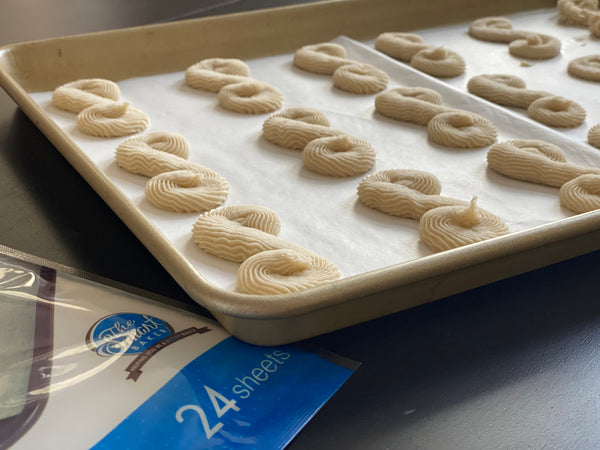Baking is a harmonious blend of creativity and science, where precise measurements and thoughtful choices can make all the difference in achieving mouthwatering results. Among the decisions bakers face is whether to use pre-cut parchment paper or non-stick pans. We'll dive into the science behind baking, and the unique roles each of these baking essentials plays and uncovering the impact they have on the outcome of your baked treats.
The Prowess of Parchment Paper:
Pre-cut parchment paper, a kitchen essential available at The Smart Baker, performs a variety of roles that are vital to baking success. Its non-stick properties ensure that your delicacies release cleanly from the pan, preserving their intricate details and shapes. Furthermore, parchment paper acts as a reliable shield against uneven heat distribution, which can lead to overcooked or unevenly baked goods.
Decoding Non-Stick Pans:
Non-stick pans have surged in popularity due to their convenience and potential to simplify the baking process. Typically coated with a layer of polytetrafluoroethylene (PTFE), or Teflon, these pans minimize the need for excessive greasing and promote uniformity in the browning of your creations. However, it's crucial to recognize that the quality of the non-stick coating can vary significantly across brands. Additionally, some non-stick cookware can do more harm than good. In this article, we've explained a bit more of the pitfalls of some non-stick bakeware.
Comparing Baking Effects:
When it comes to baking outcomes, parchment paper and non-stick pans yield different results:
1. Texture and Browning: Parchment paper fosters a slightly crisper texture and even browning, owing to the separation it creates between the batter and the pan. Non-stick pans may yield distinct textures and browning results based on factors such as pan material and coating quality.
2. Release Ease: Both parchment paper and non-stick pans are adept at preventing sticking, but parchment paper's adaptability can be especially beneficial when dealing with intricately designed or fragile baked goods. With baking parchment, we are utilizing food same silicone whereas non-stick bakeware may be using harmful chemicals not safe for ingestion.
3. Flavor Integrity: Parchment paper maintains the natural flavors of your baked goods, while concerns have been raised about non-stick coatings potentially imparting a subtle metallic taste to certain foods.
Guidance for Choosing:
To make an informed choice between parchment paper and non-stick pans, consider these pointers:
- For recipes demanding fine details or delicate textures, parchment paper is often the preferred choice.
- When opting for non-stick pans, prioritize reputable brands to ensure the longevity of the non-stick coating and address any potential health-related queries.
- Experiment with both mediums to discern their individual effects on your specific recipes and baking style.
In the realm of baking, comprehending the scientific principles behind your tools is a valuable asset for achieving consistent and delectable outcomes. Pre-cut parchment paper and non-stick pans each bring their distinctive advantages. The decision hinges on your preferences, the specific recipe requirements, and your desired final product.

